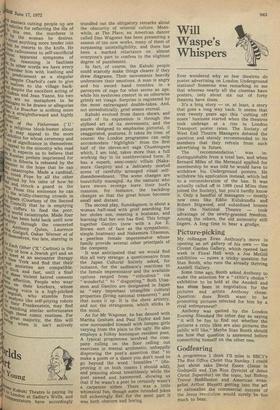:0: 411 dS (1 1 y oung 1 i4 s 5 lit t e kabuki
Theatre is paying its ,h o:rntondon at Sadler's Wells, and illentators have accordingly 1 trundled out the obligatory remarks about the obscurity of oriental culture. Meanwhile, at The Place, an American dancer called Dan Wagoner has been presenting a season of ten new works, many of them of surpassing unintelligibility, and there has been a marked reluctance on almost everyone's part to confess to the slightest degree of puzzlement. In fact, of course, the Kabuki people could scarcely make things clearer if they drew diagrams. Their movements heavily underscore their emotions. A man is angry and his sword hand trembles in a paroxysm of rage for what seems an age, while his eyebrows contort in an otherwise grimly set visage. Surprise is registered by the most extravagant double-takes. And, not unrealistically, grief seems eternal. Kabuki evolved from dance shows, and much of its expression is through the stylised art of its movements, and the pauses designed to emphasise pictorial, if exaggerated, postures. It takes its time, of course: the London programme can only accommodate ' highlights ' from the first half of the eleven-act saga Chushingura which, I am told, takes more than a full working day in its unabbreviated form. It has a superb, semi-comic villain (Nakamura Ganjiro) and a *delicately morbid scene of carefully arranged ritual selfdisembowelment. The scene changes are beautifully managed. As the samurai who have sworn revenge leave their lord's mansion, for instance, the backdrop changes so that the great house becomes small and distant.
The second play, Sumidagawa, is about a woman half-mad with grief searching for her stolen son, meeting a boatman, and learning that her son has died. This brings together Ganjiro (now with a Joe E. Brown sort of face as the sympathetic, simple boatman) and Nakamura Utaemon, a peerless female impersonator whose family provide several other principals of the company. It was anticipated that we would find this all very strange: a questionnaire from the Japan Cultural Society asked„ for instance, for the audience's reactions to the female impersonator and the available options ranged from " ridiculous " via " wonderful " to "disgusting." Both Utaemon and Ganjiro are designated in Japan as "very important intangible cultural properties (living national treasures) " and that sums it up. It is the sheer artistry, and not the strangeness, which sticks in the mind. As for Mr Wagoner, he has danced with Martha Graham and Paul Taylor and has now surrounded himself with lumpen girls varying from the plain to the ugly. He also employs a folksy homespun resident poet. A typical programme involved the company rolling on the floor calling out exercises in mental arithmetic; unhappily disproving the poet's assertion that "to make a poem or a dance you don't need to go beyond the word 'brambles'" (disproving it on both counts I should add); and prancing about breathlessly while the poet sawed and hammered, showing us that if he wasn't a poet he certainly wasn't a carpenter either. There was a little whimsical fun, though some intended jokes fell sickeningly flat: for the most part it was both obscure and boring.










































 Previous page
Previous page